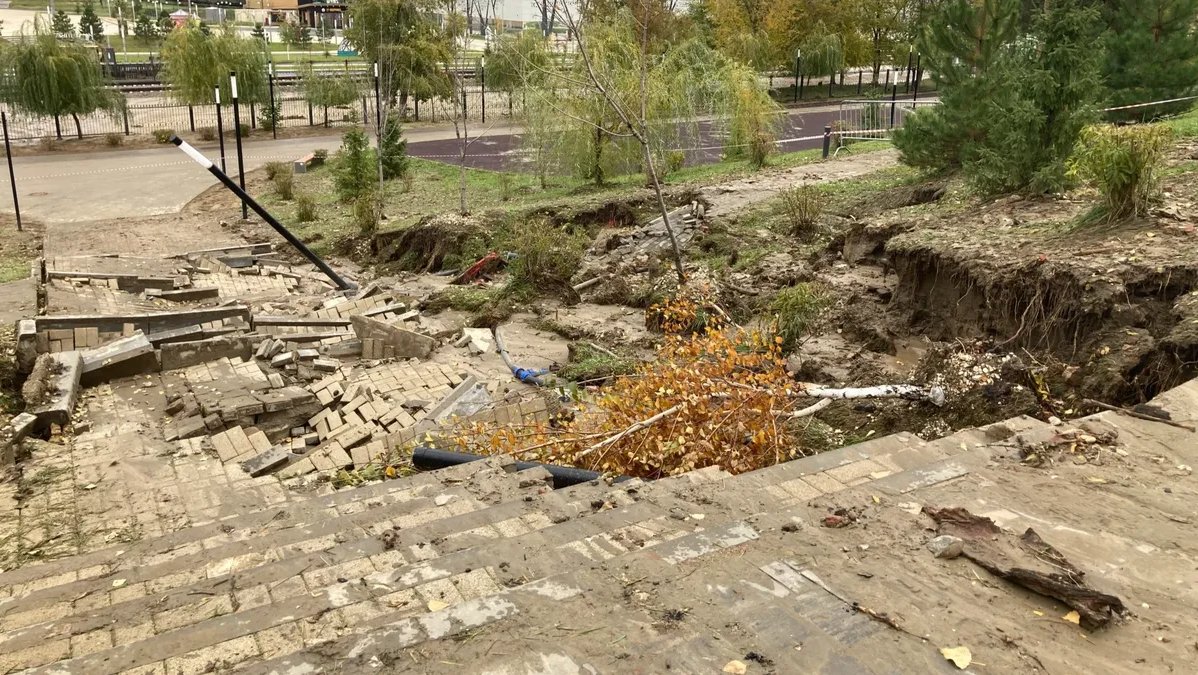The sewers in the Tsaritsa River floodplain in Volgograd, a city in southern Russia, erupted in the early hours of 27 October, flooding the nearby quarters with foul water. Three districts of the city with over 1 million residents, or about 200,000 people in total, had been stifled by horrendous stench and were left without water supply and heating for a week’s time. What is more, one of the districts was left without gas and power supply, too, while November is usually a cold month out there. It is unknown how long the foul water, along with sewage from the nearby factories and from several hospitals, flowed into the Volga River for. Volga is the source of drinking water for both the Volgograd region and the Astrakhan region, located downstream. The consequences of this disaster have yet to be assessed by environmentalists and doctors.
Happy holiday
As we approached landing, two girls on board the plane to Volgograd were discussing how they would spend the upcoming weekend in the city. I had a look at their shoes as I began to read what Russia’s federal TV channels have been reporting about Volgograd in recent days. One only mentioned the city in the news of its local branch, the other touched upon Volgograd in early October in connection with the “historical reconstruction of the battles for Stalingrad”. Meanwhile, the city was suffering the largest utility disaster in recent years, the one that could potentially become an environmental and medical catastrophe.
But the tourists who took the plane to Volgograd to enjoy the sights turned out to be right. While the city’s residents were still without water, power, gas, or heat supply, the local authorities were taking them to a rally “in support of the special military operation”. It was decided to combine the rally with a religious procession devoted to the Day of National Unity, a nationwide holiday celebrated in Russia on 4 November. The location had to be changed, however: the authorities were planning to lead the folk into the floodplain of the Tsaritsa River, to the newly opened public garden, their recent pet project. This had to be cancelled, though, as it still stank there. The final decision was to hold the celebrations on the Volga embankment near the fountain, which was turned off for the winter. I doubt that those who picked the location realised how symbolic the “dried-up” fountain looked these days in Volgograd.
The festivities started off with a divine service at the Alexander Nevsky Cathedral, opened last year on Lenin Street. From half past seven in the morning, groups of Emergency Ministry employees and Cossacks had been guarding the place outside the cathedral.
“You have to look at the stripes on their clothes,”
a Cossack wearing a black and red chokha, with a dagger, orders and medals, taught me how to tell between the two varieties of Cossacks.
“We are Kuban Cossacks, and those are Donians.”
A group of young people wearing camouflage and “patrol” armbands, armed with truncheons, were inspecting the bags of the Orthodox believers near the fence where a metal detector was installed.
“We were told there would be terrorists here,” a young patroller said to me. “We are of the National Guard. Do we support the war? Yes, we do. Our unit is currently in Melitopol. No, they won’t send us there because we are conscripts. But we fear that we might be drafted again once we finish our term. They say: sign a contract now, and you’ll get the best items there are. Fat chance…”
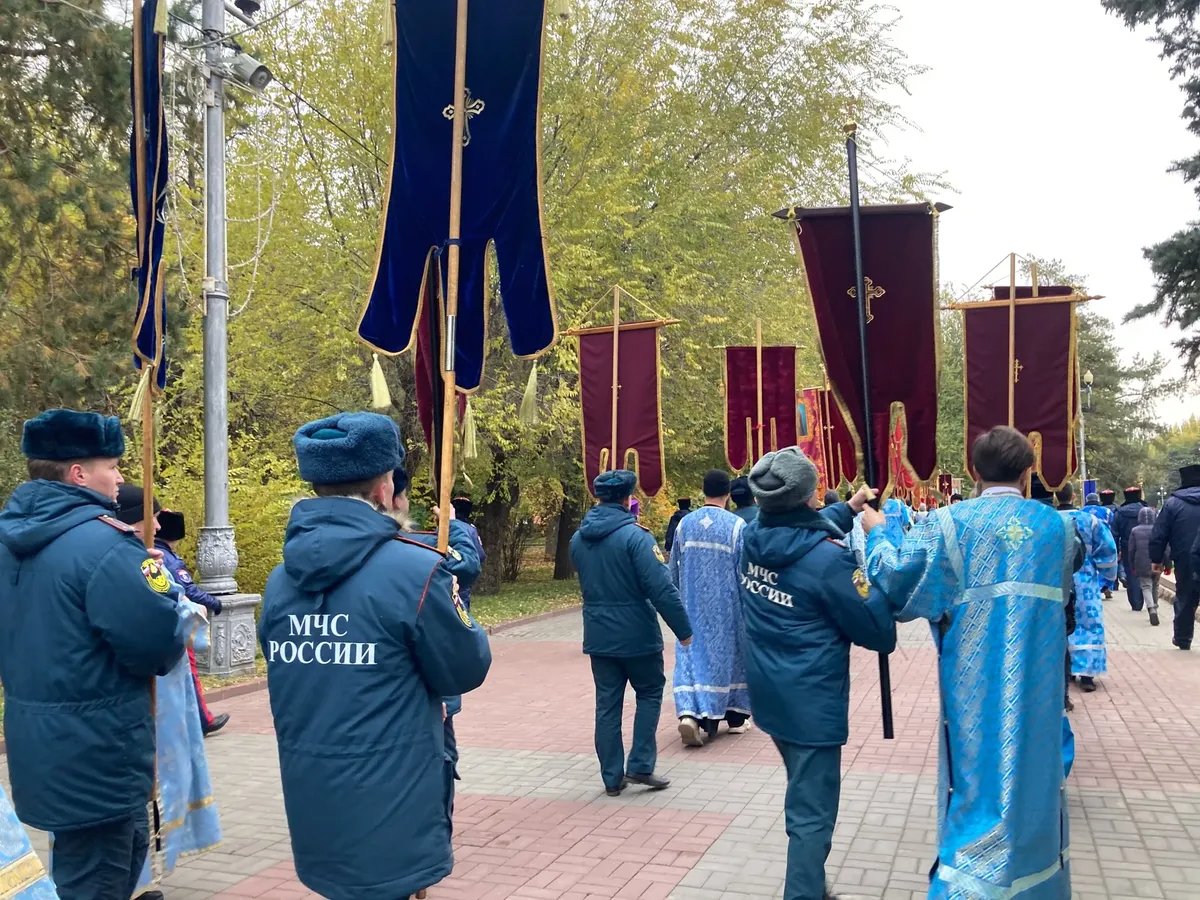
Emergency Ministry employees carry church banners during the religious procession. Photo by Irina Tumakova for Novaya Gazeta Europe
When the service was over, the priests with church banners headed to the embankment where the dried-up fountain was located. The banners were carried by the Emergency Ministry guys, and the whole group was guarded by the Cossacks from both flanks. A priest holding a silver-coloured chalice would approach the worshippers every now and then, and another priest would pour holy water into the chalice from a plastic bottle with a Gift of the Volga label on it. This water was used generously to asperse the believers.
“Our water is from the Volga,” a priest tells me, and just to put me at ease adds: “This isn’t dangerous, the eruption was lower downstream.”
“I thought you would say that it wasn’t dangerous because it’s holy water,” I responded.
“Of course it’s holy!” the priest replies on second thought.
The priests lined up in front of the recently erected stage on the embankment, blocking off their orator from the crowd. The orator would speak about the Time of Troubles, a period of political crisis in Russia that lasted between 1598 and 1613, which, he said, ended on 4 November (historians provide a different date, but who cares).
“Today, Russia is opposing the aggression of the collective West, and our spiritual values are under threat,” the priest concluded his speech. “Happy holiday, dear brothers and sisters!”
The church bells stopped ringing, and the intermission that followed sounded as if a disco party would be announced right away. Indeed, pop music came blasting from the speakers, and a couple of announcers wearing warm clothes jumped on stage. The female one declared with a girl scout voice that “our goal is to preserve peace”. Somehow, she wasn’t charged with discrediting the Russian army immediately thereafter.
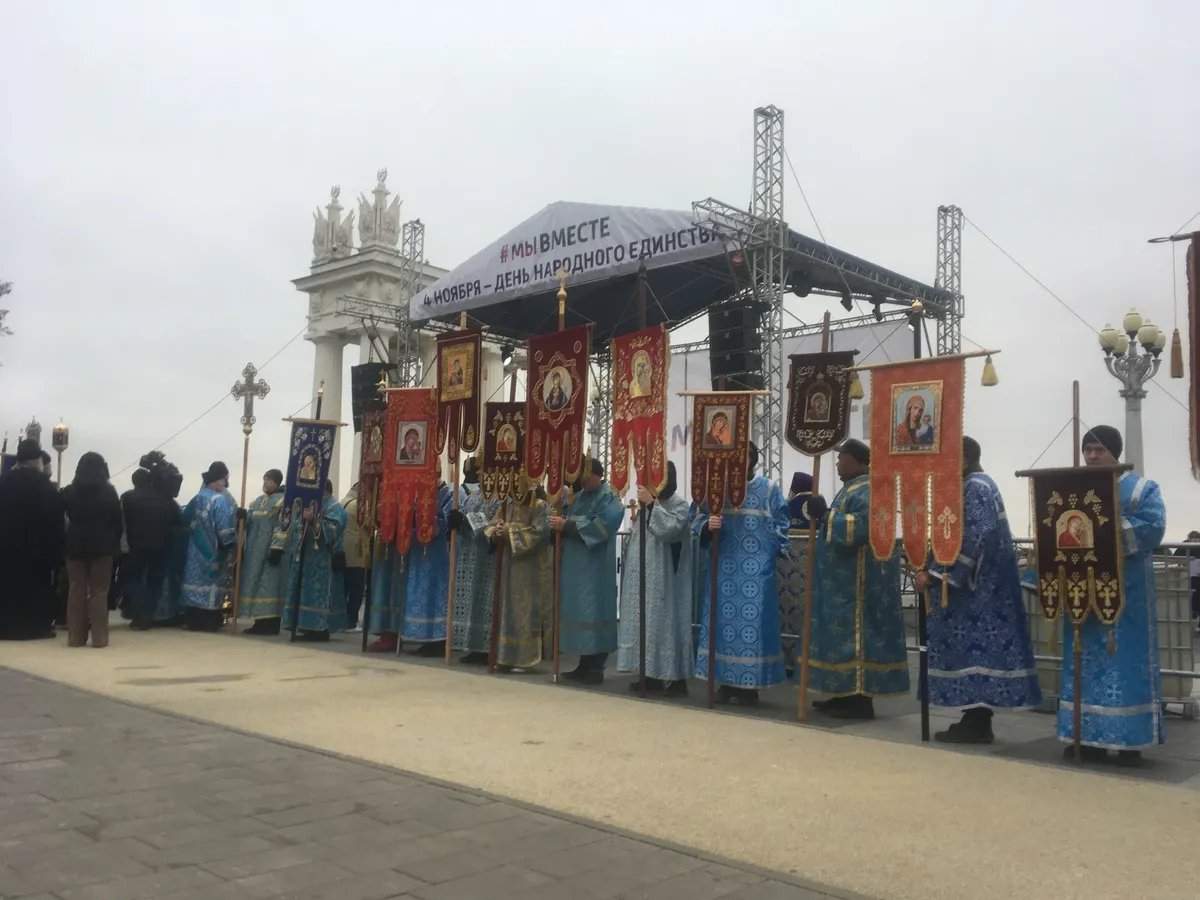
The stage on the embankment. Photo by Irina Tumakova for Novaya Gazeta Europe
“I came home yesterday, and there was no running water,” a lady wearing glasses, her back turned to the stage, was complaining in the crowd.
“We haven’t had water for almost a week,” her friend shrugged her shoulders. “These ‘festivities’ here… I was forced to go by my college.”
“Do you have water supply at your home?” I asked another lady.
“Oh, let’s not do demagoguery here,” she grimaced and turned away.
A stocky man was running back and forth along a group of gloomy-looking young people holding United Russia banners.
“Guys, let’s get together for a picture. Look nice, everyone!” he said, waving his hands. “Come on, look nice!”
The youngsters were shifting from one foot to the other. They couldn’t give him “nice”.
A woman in a white jacket was selling Russian flags beside the dry fountain, but no one agreed to buy those for 300 (€5), 500 (€8), or 800 (€13) rubles. Passing by was a column of people wearing St George’s bands and icons of saints on their chests.
“We are now liberating our Fatherland within the 1945 borders,” an old man who introduced himself as Yevgeny said to me. “Those territories were unlawfully separated from us. The Ukraine War is happening because Ukraine is an illegitimate state, it is in fact part of Russia.”
“Actually, everything is part of Russia,” Natalya, a woman nearby, corrected him.

Photo by Irina Tumakova for Novaya Gazeta Europe
“Well, if they don’t want to return, should we take them by force, like we did with Ukraine?” I asked her.
“Yes, yes,” she rejoiced at hearing this. “There are NATO troops in the Baltic States. NATO should withdraw their troops from there, because it’s a disputed territory.”
“Shouldn’t we fix the sewers first?” I spoke.
“We’re solving political issues rather than utility ones,” Yevgeny replied with resentment. “We are liberating our country. Once we become a rich country, we’ll fix the sewers.”
“First we need to defeat Kyiv and liberate our territories,” Natalya replied flatly. “And leave other issues aside for now.”
Meanwhile, some people still had no water, heating, power, and gas supply, and the repairs had been going on for a week.
‘Bocharov creek’
Sergey Ostrovsky, a local activist who has been fighting, as he puts it, against utility lawlessness in the city and for the preservation of cultural heritage for many years, took me to the crash site on the evening of this festive day. We stood in the middle of a beautiful park with shiny illumination.
“The place where a fountain of foul water from two districts, Voroshilovsky and Sovetsky, erupted is over there,” Sergey says as he points up the stairs.
The concrete staircase has been turned inside out and shattered by a stream of faeces erupting from underneath the ground. The grass here is still covered with puddles of brown liquid that gushed from the breach, and the smell is horrible. Having escaped from the pipe, the faecal waters rushed down the wreckage of the stairs, then along the road and straight into the Volga. The locals ironically dubbed this water flow ‘Bocharov Creek’ after Andrey Bocharov, the local governor [Bocharov Creek is the name for the summer residence of the Russian president — translator’s note].
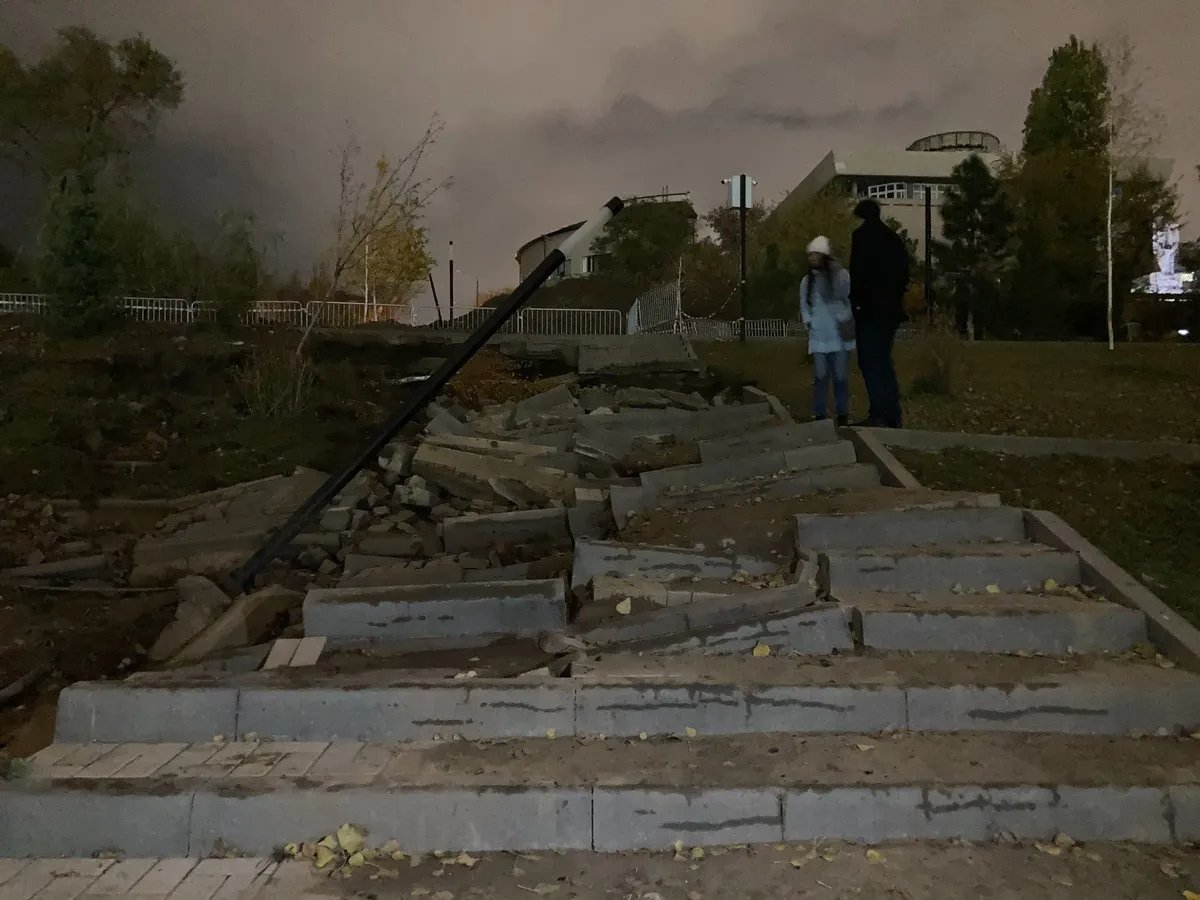
Photo by Irina Tumakova for Novaya Gazeta Europe
It’s nearing nine in the evening, and only now the eruption location can be reached. The place was closed off with tape during daytime, but now there are only fragments of that tape on the ground. I will return to the spot in the morning to see the tape set up again, but now we see a young couple walking here in the park, running the risk of tripping into the wreckage, breaking their legs, or finding themselves in a stinky puddle. I’m taking pictures of the place with my camera, flashlight on, and Sergey is using his electric torch, so the two notice the wreckage before it’s too late.
“This is the Tsaritsa River floodplain,” Sergey says, pointing over the surroundings. “There’s an open-air museum up there, called Russia Is My History.”
There used to be a ravine where we are standing now, and the Tsaritsa River used to flow through it. The river is still there, but a part of it, a couple kilometres long near the estuary, the place where the Tsaritsa flows into the Volga, was enclosed within a concrete tunnel in the 1970s. The tunnel is now used as a storm water drain. Nearby are the pipes of a utility drain, receiving foul water from two districts of the city. Normally the foul water would go through these pipes into the sewage treatment works, and then into the Volga.
The ravine used to be a wasteland for a long time, and an impromptu landfill, then the authorities started to develop the area at a frantic pace. The Volgograd branch of the Russia Is My History project and some parks were opened on the left side of the ravine, within the Tsaritsa floodplain, in 2017. They did it in record-setting time. The right side of the ravine was developed in 2019, and now there’s a public garden named after Alexandra Pakhmutova, a composer born in Volgograd. The Tsaritsa tunnel was left underground. So, the utility drain goes near it, and both of its pipes burst in the early hours of 27 October.
Those were two pipes of steel, 1.2 metres across, and, as it turns out, they were simply rotten. The locals sounded the alarm on the evening of 27 October.
“It was around nine p.m. when the parents of a friend of mine were walking through the park and smelled the foul stench, then they heard the purl of water and saw some stream that was rushing through the park,” says Sergey. “They approached the slope and saw that it was being washed away, the staircase was destroyed, and a landslip seam appeared in its place. They started calling the emergency services right away.”
However, there’s an issue with the Volgograd emergency services, Sergey says: few people manage to reach those on the phone, and those who do are usually asked to wait indefinitely. The same thing happened when the slope washed away, he says.
The entire sewage system in the city is run by a private company called Water Supply Concessions via an agreement with the local authorities. This company collects fees from individuals and enterprises and is responsible for the state property. When Sergey’s acquaintances finally reached the dispatcher, they were offered to wait.
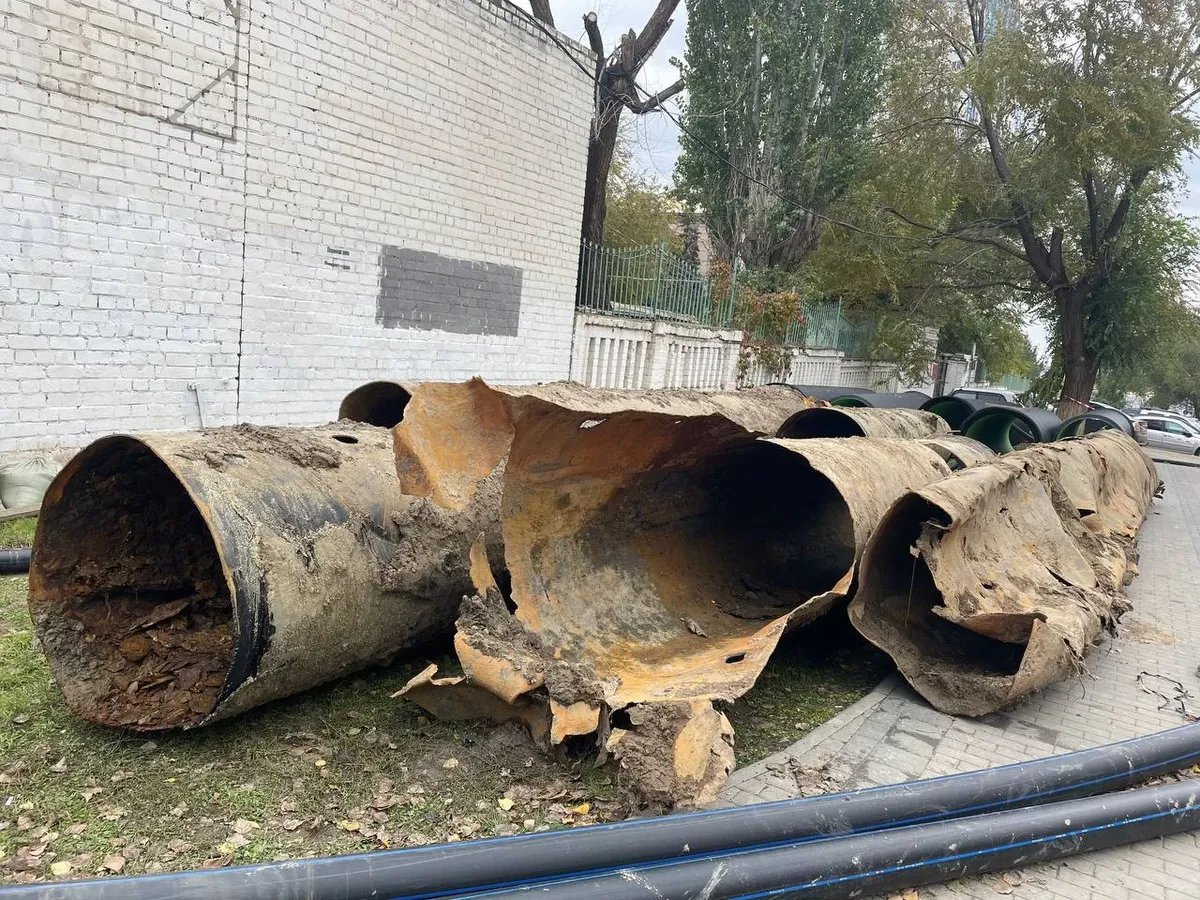
The pipes. Photo by Sergey Ostrovsky
“They were waiting for two hours there,” Sergey says. “And then their daughter gave me a call. I called another acquaintance of mine, a utility services official, and he asked me to send him a video, which I did. The city’s administration reacted after 11 o’clock; two deputy mayors arrived at the location. They only set up some tape around the place and went to bed.”
The flow of faeces flooded the public garden and the street that runs along the embankment. Cars drove by the street with wheels submerged into the foul water. Judging by the statement of the Investigative Committee, which would be published three days later, the eruption occurred the day before it was noticed, overnight into 27 October, and then the local authorities did not block the faeces from flowing into the Volga for an entire night. The repair team only arrived on the morning of 28 October.
A command centre was set up at the location, led by Andrey Bocharov, the governor. He ordered to start draining the faeces no later than 31 October, as Unity Day was approaching. It seems that the governor was thinking that some proper festivities could still be salvaged at that moment. He gave a press conference afterwards, declaring that the poor state of the sewers was a total surprise for everyone. Who would have thought that the pipes built just 50 years ago might need renovation? This short lifespan of the pipes outraged the governor.
Concessions and water supply
The Water Supply Concessions company took charge of the facilities in 2015. It is fair to say that the company was meant to have inspected the venue back at that time.
“There was no inspection,” says Yury Chevtaev, the former head of the workshop for main sewerage networks and the operation of tunnels at the Volgograd water and sanitation authority. “The first thing they did was cut the number of linemen who were supposed to monitor the condition of the pipelines on a daily basis.”
I did not find any evidence of the facilities being inspected, some sort of a contract between the company and a contractor, in the state procurement database.
In any case, the company publicly estimated the total wear and tear of the sewage system in Volgograd at 70% back at that time, repairing an average of 10 to 15 minor breakages daily.
The company announced the “start of modernisation” of all systems: it promised to lay 25 kilometres of new pipes to replace the old ones and to replace 180 kilometres of pipelines in the space of three years, spending 7 billion rubles (€112m) on the maintenance work. Although the company’s first accomplishment turned out to be not the repairs of the pipe network but the construction of an artificial ice-skating rink that cost 46 million rubles (€736,000). The ice rink was opened during winter, it stayed open for three days, after which it melted down. The company blamed the weather anomaly that made it unusually warm.
Water Supply Concessions for some reason did not start on the repairs of the pipes located in the Voroshilovsky and Sovetsky districts of the city. But they did build a new water supply in the neighbouring Central district. It broke three months later.
As a reminder, a park and the Russia Is My History museum were opened in the Tsaritsa River floodplain in 2017. In 2019, it was decided to beautify the right side of the ravine too, by building another public garden there. That was another moment when the sewers needed to be inspected. At least due to the fact that construction of concrete staircases, laying sidewalks, installation of lights, benches, and other objects could increase the load on the structures located underground. The public garden cost 142 million rubles (€2.27 million). There is no inspection of underground utilities mentioned on the list of the work performed during the construction. The builders just said: everything was done so well that there would be no need to “break down cobblestones due to leakage.” Three years later — water “broke down” the stones on its own.
Deputy for the Volgograd City Council Ilya Kravchenko thinks that faecal waters were flowing into the Volga for much longer than two days. The first time he tried to inform the authorities and utility services of the issue was in 2019. If someone had paid attention to the problem back then, then the public garden opening ceremony would have, possibly, had to wait for some time, but it would have stayed open for longer.
Ilya says that diggers went down to the floodplain of the Tsaritsa River in 2019, to the part that had turned into the storm water drain, and discovered that some faecal water was definitely flowing down there. It could have appeared from the nearby utility sewers pipes. That was a sign that something was wrong with the pipes. Diggers told the deputy about their findings. He went down to the drain himself to check. It was then, Kravchenko says, that his correspondence with the authorities began — from the environmental prosecutor’s office to the governor’s administration. He has a whole archive of the replies he has received. From the responses, he learnt that the storm water drain belongs to no one, that no one is responsible for it, and that there is no one to check his information.
“In the prosecutor’s office, I was told that they couldn’t go down there,” he scoffs. “Do they not have legs? Why could I go down there with a flashlight, and they can’t?”
Ilya Kravchenko started a new round of correspondence with the facilities back in the summer. There were still a few months to go before the eruption. The deputy did not receive a reply to his last letter, although state authorities must respond to all queries within a week. Before they could do that, the sewers erupted, making it clear for everyone what state the city sewage system is in.
Everything was rotten, not only the sewage system
The burst utility drain is used to service the residential buildings housing almost 200,000 people. At first, the repairs were supposed to be carried out without the water being turned off. It’s unclear how they planned to do it: if 200,000 people as well as enterprises, schools, kindergartens, and hospitals, use water, then it needs to flow down somewhere. So, the water was eventually turned off. But it turned out to be impossible, to the utility providers’ surprise, to start the repairs immediately.
“People need to somehow continue living,” Sergey Ostrovsky explains. “The water in the faucets did indeed get turned off, but still, water had to be delivered in trucks. People used that water — and it went down the same drain.”
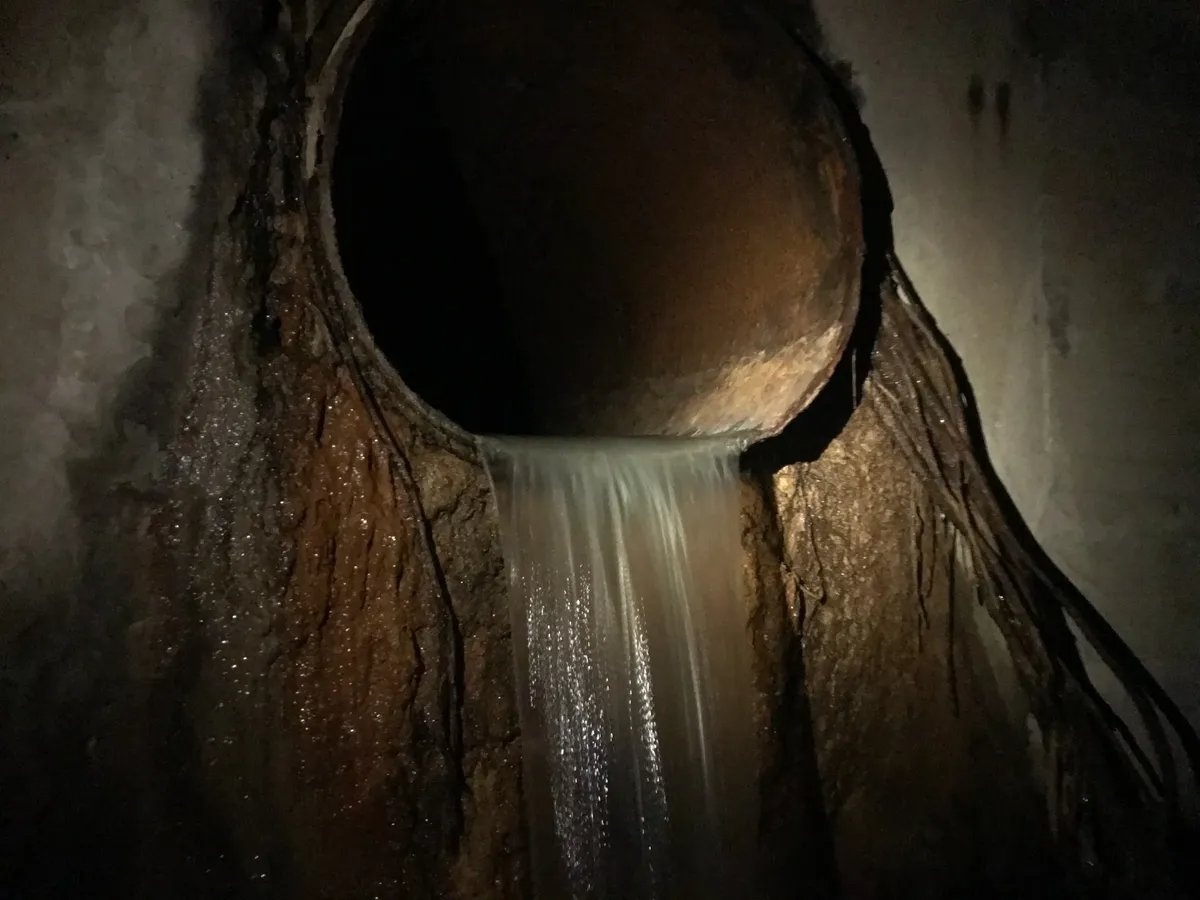
The sewage. Photo by Irina Tumakova for Novaya Gazeta Europe
The situation was helped by the fact that Volgograd’s water transportation system was also not up to par. Ivan who lives in the Sovetsky district told me that his wife had to move to her parents’ place for a while, because at first, no water was being transported at all, while later, giant queues lined up for the vehicles carrying water.
“I work in shifts; my wife is pregnant. She can’t stand in the queue on the street and then carry a canister,” Ivan says.
A married couple Anna and Nikolay who live on Tulak Street did pretty much the same thing. When we met, they still had neither water nor central heating. They went to their friends’ place on the outskirts of Volgograd to wash up; they got potable water from a spring. Thank God, Anna said, that they have a car. Lyuba, who earns money by growing flowers for sale, had to book a room in a hotel and bring water from there to her home so she could water her plants.
But most Volgograd residents did not have an opportunity to move out from their place. First, all potable water was swept from the shelves. According to Lyuba, five-litre water bottles tripled in price, but it still was impossible to find any near one’s home. In theory, people knew that portable water was being carried around the city in some orange tankers. But I was unable to find anyone who has received water from such a tanker even once.
“The locations of drinking water stations remained unknown,” deputy Kravchenko says. “One of our local outlets managed to get a copy of some list, but it featured only addresses for one day, and the contacts on the lists were phone numbers of the drivers. This information was not of any use, because drivers changed [vehicles]. People called them to find out where the tanker was located, while that driver was already behind the wheel of another vehicle.”
Volgograd residents were promised to have technical water delivered to them via fire trucks. They were urgently collected across all neighbouring districts and villages, as many as were available. But there was no schedule for the trucks’ movement. Rather, there were two schedules: one from Water Supply Concessions and one from the city administration. Both did not match the real schedule.
“Fortunately, it was raining in Volgograd during those days,” Sergey Ostrovsky tells me. “And whoever managed to do it in time — they put a bucket under a downspout. Some people collected raindrops from garages’ slate roofs. Some collected puddle water to at least use for the toilet.”
Volgograd residents filmed all of this and posted the videos on social media. To the local authorities’ horror. The skills people had learnt during the pandemic ended up being of use: they came together, quickly organised in groups, began using group chats and helping each other. Someone at last managed to get the real schedule from the authorities, it was shared across the group chats.
“And still, water trucks did not arrive on schedule,” Sergey Ostrovsky notes. “In some places, the trucks came on time, in other places — no. But people really came together to fight this problem, it was a very positive thing to see.”
Then, it turned out that the water provided by the authorities was not always usable, even for the bathroom. In some cases, it was better to collect puddle water.
“For example, this water was delivered,” Sergey shows me a photo on his phone of a dirty-brown liquid that looks as if it was actually collected in the burst sewage. “When asked why the water looked like this, people were told: these are the barrels [we have]. These are the barrels belonging to the fire trucks, nothing anyone can do.”
The delivery of technical water was more or less set up after a while — then, the repair work got more difficult.
On the third day, a state of emergency was introduced in the city districts affected by the eruption. But the repairmen managed to heroically complete their work. The local governor promised that water would start returning to flats in a “thin trickle”. And then, it turned out that there was trouble with central heating too.
“After all, everything was rotten, not only the sewage system,” Sergey Ostrovsky waves his hand around. “The city heat supply is in poor condition. Specialists qualify its state as emergency-uncontrollable.”
The valves that are supposed to contain the hot water used for heating deteriorated and were unable to keep the water inside.
“Before the eruption, battery water dripped down into the sewage all the time,” Sergey continues. “That’s because shut-off valves in heat cameras were also so rotten and old that water flowed down all the time. We saw it during winter, there was steam coming from under the ground all the time. Before, I just noticed the steam, but I now understand what it was.”
Thus, radiators had to be turned off for repair work. At that time, the night temperature in Volgograd fell down to 0°. A third district joined the previous two that had been left without water and with cold batteries.
“In the Krasnooktyabrsky district, something happened to power, basically it turned off,” Volgograd resident Dmitry tells me. “Well, because of that, the boiler room stopped working, so we had to do without heating. Maybe for the same reason, because of the electricity being turned off, or maybe because people started using their ovens to get warm, gas also got turned off.”
Public service workers heroically managed to repair the burst pipe on 2 November, the sixth day after the accident. Only one of the two pipes, but even this accomplishment was a big deal. Governor Bocharov came down to the repair site once again, so he could grandly announce the relaunch of the system.
He was actually in the middle of saying that by 4 November, the day of the celebrations, everything would be fixed, when a new fountain started erupting three metres away from him. The pipe burst in another place.
“At that moment, I actually felt bad for the governor,” Sergey Ostrovsky says. “But can you imagine: these are two pipes with a diameter of 1.2 metres each — not a primary one and a backup one, this is basically one whole drain made up of two strings. We simply don’t have pipes of a bigger diameter. A sewage system is like Niagara Falls shoved into a pipe. So, what happened was that pressure designed for two pipes was redirected into one pipe. So, another rotten part of the same pipe burst. According to one version, it couldn’t hold the pressure. But there’s another version: that an excavator accidentally touched the pipe with its ladle. But they somehow managed to repair this too, although I don’t understand how.”
Gradually, water was being turned on in the flats, just like the governor promised, in a “thin trickle”. But only technical water. The fact that it would only be technical water was mentioned in passing. For five days, [Russia’s consumer rights protection regulator] Rospotrebnadzor stayed quiet, and then the agency just sent out letters to the affected districts’ residents: it was “suggesting… to make sure the residents are informed” about the fact that it would be better to boil tap water, once it turned on. This statement was echoed by the utility companies: it was written in the leaflets that were later delivered to the residential buildings that Rospotrebnadzor “suggests using the supplied water after boiling it”. Not insists, not even recommends, but suggests.
“Furthermore, Rospotrebnadzor’s letters applied only to two districts — the Voroshilovsky and the Sovetsky ones, the ones that were directly affected by the eruption,” Sergey emphasises. “But water intake from the Volga River, into which the faecal matter had spilled, also happens in the Kirovsky district of the city, in the Krasnooktyabrsky district, and in several districts of the Volgograd region, which are located down the river. All of these places receive this water. And during those days, not only faecal matter but also wastewater from several hospitals, car washes, dry cleaners, and many other enterprises was being spilled into the Volga River.”
Bomb under the Russia museum
At the same time, the storm water drain — the Tsaritsa River — continues living its own life enclosed within a concrete tunnel with a diameter of 2.5 metres. As a reminder, it was thanks to this storm drain that local deputy Ilya Kravchenko started suspecting something wrong in the faecal department back in 2019.
“No one ever found out why faecal matter was spilling down there,” Ilya notes. “I think it has to be looked into, whether it’s flowing down there right now. If not, then it means that for the last three years the pipes that recently burst had been making their presence known: it was their contents flowing down to the storm drain. But if the spill down there continues, it means that the same pipeline has another hole somewhere.”
If you study the map location of the utility drain to see from which point on the map something could be spilling down to the storm drain, then you will no longer see the public garden with the staircase and the sidewalks but the Russia Is My History museum.
“It means that the faecal bomb is placed under Russia,” Ilya quips.
To see how the storm drain is doing, we go down to the drain. The one referred to by the prosecutor’s office in their replies to the deputy as “inaccessible”. It is indeed not very easily accessible. It would be hard to call the journey down there a nice walk.
Ilya is carrying a giant backpack. He meticulously inspects my equipment. He finds my jacket acceptable. My boots make him laugh. He takes out welly boots that are almost as tall as me from his backpack. Then, we enter the drain.
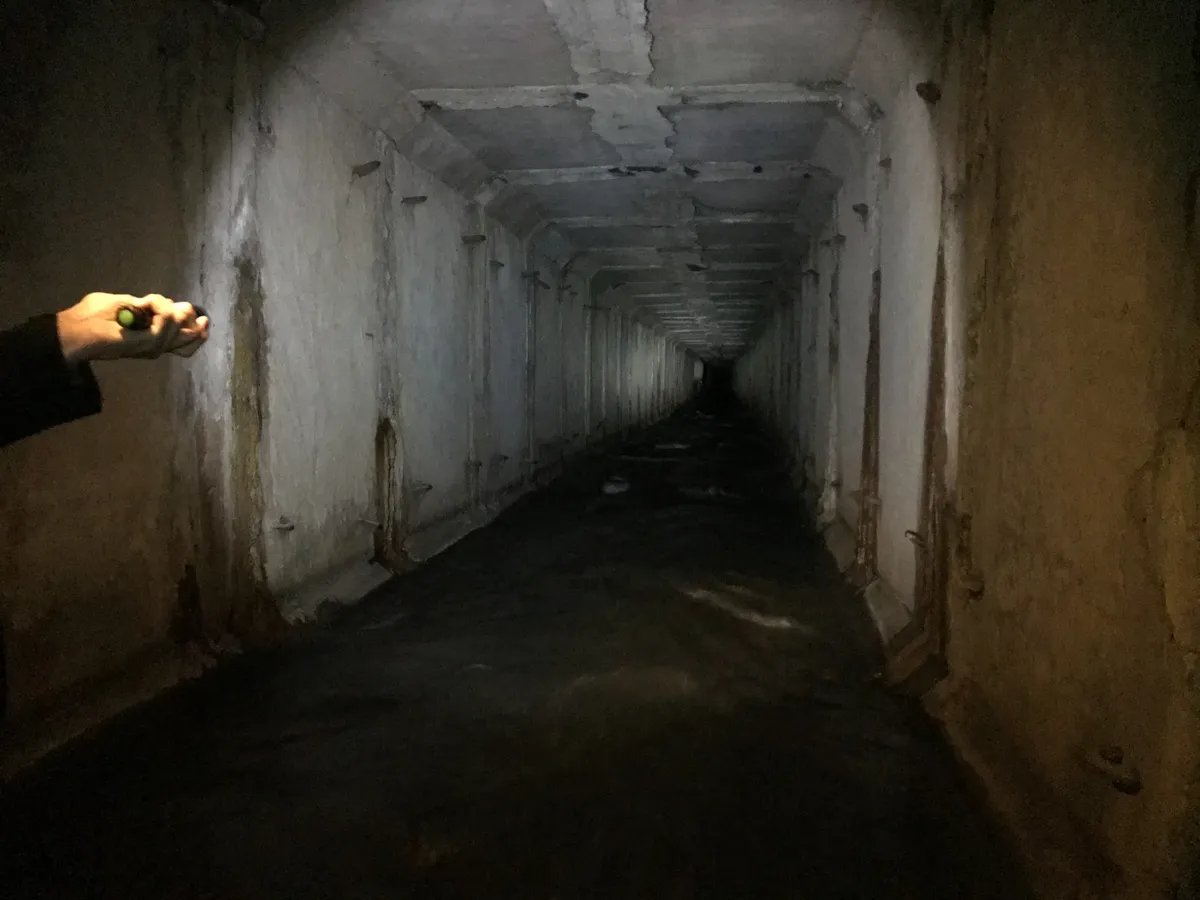
The drain. Photo by Irina Tumakova for Novaya Gazeta Europe
The river chained by concrete is quite shallow, the deepest parts reach a bit farther than my knees. The flow of the river is very strong, but I will only realise that on the way back when we have to go against it. Even the boots will not help by that point, you will still be walking out covered in the drain’s contents. The floor is full of garbage, it is very easy to trip and fall down into the water.
Metal pipes are carved into concrete walls, along which street water drips down here. The water is almost clear: if you use a flashlight, you can see the floor. Further on, the stream enters the Volga River. About fifty metres further, the smell changes: here it is. This is the sign of the faecal waters flowing down here.
“No, this is almost normal now,” Ilya shakes his head. “Before, the smell was so bad that people almost lost consciousness in here.”
We have reached the source of the smell: along one of the pipes, it is not rain water from the streets that is dripping into the drain but brown and smelly water. Further on, the path is slippery. Although, Ilya notes, everything looks better, clearer than during his last visit — before the eruption. In theory, it could mean that the repaired pipe is the one that was spilling crap into the Volga River all this time, and that with more time passing, if nothing else breaks or bursts, the remaining colour and smell will disappear. But even after this walk, I am no faecal matter expert. Neither is deputy Kravchenko. So, not everything is clear when it comes to the faecal bomb placed under Russia.
P.S.
P.S. While this story was being written, another sewage eruption occurred in the south of Volgograd.
Join us in rebuilding Novaya Gazeta Europe
The Russian government has banned independent media. We were forced to leave our country in order to keep doing our job, telling our readers about what is going on Russia, Ukraine and Europe.
We will continue fighting against warfare and dictatorship. We believe that freedom of speech is the most efficient antidote against tyranny. Support us financially to help us fight for peace and freedom.
By clicking the Support button, you agree to the processing of your personal data.
To cancel a regular donation, please write to [email protected]
